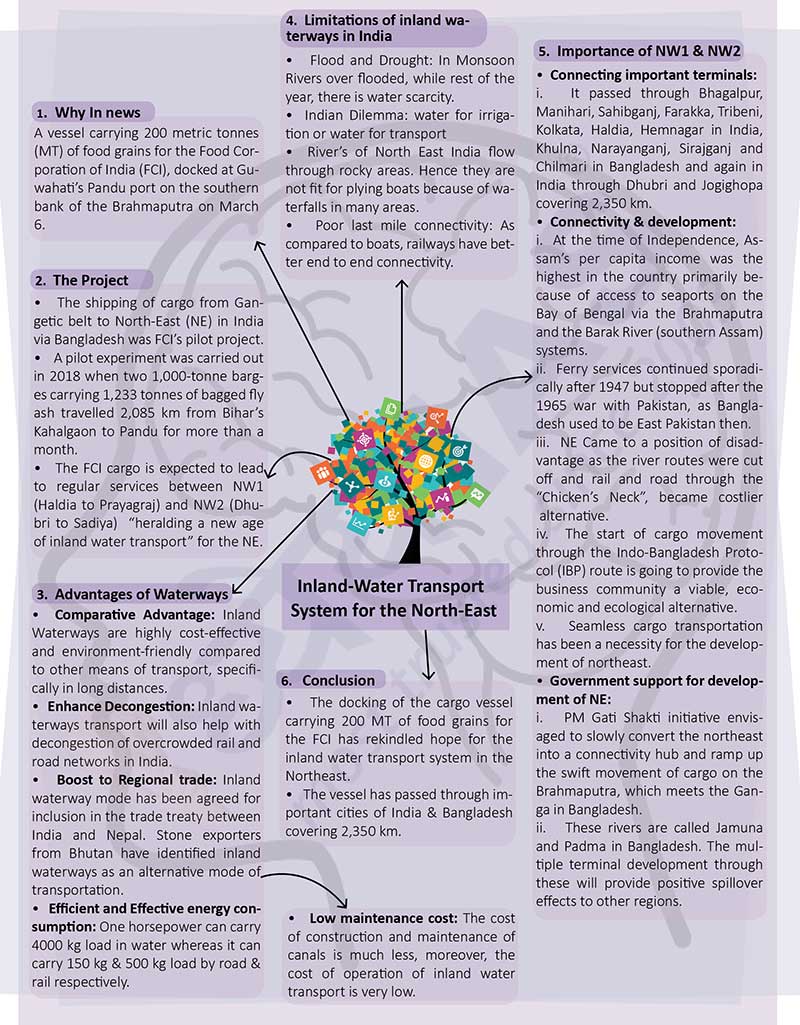Why In news?
- A vessel carrying 200 metric tonnes (MT) of food grains for the Food Corporation of India (FCI), docked at Guwahati’s Pandu port on the southern bank of the Brahmaputra on March 6.
The Project
- The shipping of cargo from Gangetic belt to North-East (NE) in India via Bangladesh was FCI’s pilot project.
- A pilot experiment was carried out in 2018 when two 1,000-tonne barges carrying 1,233 tonnes of bagged fly ash travelled 2,085 km from Bihar’s Kahalgaon to Pandu for more than a month.
- The FCI cargo is expected to lead to regular services between NW1 (Haldia to Prayagraj) and NW2 (Dhubri to Sadiya) “heralding a new age of inland water transport” for the NE.
Advantages of Waterways
- Comparative Advantage: Inland Waterways are highly cost-effective and environment-friendly compared to other means of transport, specifically in long distances.
- Enhance Decongestion: Inland waterways transport will also help with decongestion of overcrowded rail and road networks in India.
- Boost to Regional trade: Inland waterway mode has been agreed for inclusion in the trade treaty between India and Nepal. Stone exporters from Bhutan have identified inland waterways as an alternative mode of transportation.
- Efficient and Effective energy consumption: One horsepower can carry 4000 kg load in water whereas it can carry 150 kg & 500 kg load by road & rail respectively.
- Low maintenance cost: The cost of construction and maintenance of canals is much less, moreover, the cost of operation of inland water transport is very low.
Limitations of inland waterways in India
- Flood and Drought: In Monsoon Rivers over flooded, while rest of the year, there is water scarcity.
- Indian Dilemma: water for irrigation or water for transport
- River’s of North East India flow through rocky areas. Hence they are not fit for plying boats because of waterfalls in many areas.
- Poor last mile connectivity: As compared to boats, railways have better end to end connectivity.
Importance of NW1 & NW2
Connecting important terminals:
- It passed through Bhagalpur, Manihari, Sahibganj, Farakka, Tribeni, Kolkata, Haldia, Hemnagar in India, Khulna, Narayanganj, Sirajganj and Chilmari in Bangladesh and again in India through Dhubri and Jogighopa covering 2,350 km.
Connectivity & development:
- At the time of Independence, Assam’s per capita income was the highest in the country primarily because of access to seaports on the Bay of Bengal via the Brahmaputra and the Barak River (southern Assam) systems.
- Ferry services continued sporadically after 1947 but stopped after the 1965 war with Pakistan, as Bangladesh used to be East Pakistan then.
- NE Came to a position of disadvantage as the river routes were cut off and rail and road through the “Chicken’s Neck”, became costlier alternative.
- The start of cargo movement through the Indo-Bangladesh Protocol (IBP) route is going to provide the business community a viable, economic and ecological alternative.
- Seamless cargo transportation has been a necessity for the development of northeast.
Government support for development of NE:
- PM Gati Shakti initiative envisaged to slowly convert the northeast into a connectivity hub and ramp up the swift movement of cargo on the Brahmaputra, which meets the Ganga in Bangladesh.
- These rivers are called Jamuna and Padma in Bangladesh. The multiple terminal development through these will provide positive spillover effects to other regions.
Conclusion
- The docking of the cargo vessel carrying 200 MT of food grains for the FCI has rekindled hope for the inland water transport system in the Northeast.
- The vessel has passed through important cities of India & Bangladesh covering 2,350 km.







